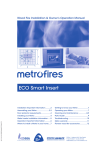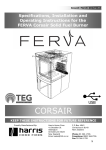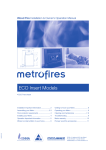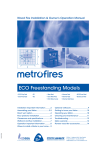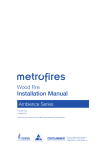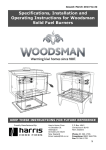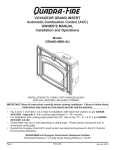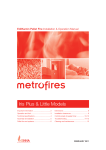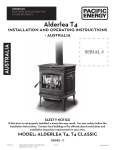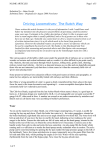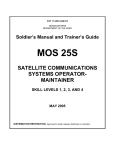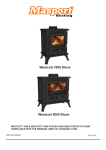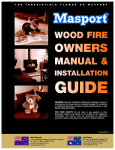Download metrofires ECO Mega Smart Installation manual
Transcript
Wood Fire Installation & Owner’s Operation Manual M1120 10/14 © PIONEER MANUFACTURING LTD ECO Mega Smart Built-In Installation Important information...........2 Where to install a Metro in your home.....8 Preparing the wall/opening cavity..........3 Getting to know your Metro.....................8 Installing your Metro.................................4 Operating your Metro...............................8 Floor protector requirements....................5 Cleaning and maintenance ..............9-10 Flue and wetback Installation.................6 Troubleshooting......................................11 Operation Important information............7 Metro warranty.......................................12 PO Box 11, Inglewood 4347, New Zealand Ph (06) 756 6520 • Fax (06) 756 6540 [email protected] • www.metrofires.co.nz WARNING! Important Information • WE HIGHLY RECOMMEND YOU READ THIS ENTIRE MANUAL AS INCORRECT OPERATION, MISUSE AND/OR LACK OF MAINTENANCE WILL VOID THE WARRANTY • The appliance and flue-system shall be installed in accordance with AS/NZS2918 and the appropriate requirements of the relevant building code or codes • Any modification of the appliance that has not been approved in writing by the testing authority is considered to be in breach of the approval granted for compliance with AS/NZS4013 and will void the warranty • The appliance must be installed correctly. We recommend a competent and suitably qualified NZHHA installer This Metro wood fire has been tested to and complies with AS/NZS 2918:2001 when installed in accordance with this manual. Please ensure you are fully conversant with this relevant standard and the contents of this manual. Correct installation is critical to the safe operation and performance of this wood fire. CAUTION! Important Information •A minimum length of 4.0 metres of 150mm diameter flue pipe is required. The total length of the 150mm flue pipe must be fully encased from top to bottom with a 200mm diameter inner casing and a 250mm diameter outer casing. CAUTION! Important Information •Mixing of appliance or flue-system components from different sources or modifying the dimensional specification or components may result in hazardous conditions. Where such action is considered, the manufacturer should be consulted in the first instance •Do not install a Metro fire if there is any sign of visible damage to the product • This appliance must be regularly maintained. • Use authorised Metro replacement parts only. The use of unauthorised parts may void the warranty • This manual must be left with the home owner Please take particular note of the following: • All flue joints must be sealed and riveted; the bottom of the flue in particular MUST be fully sealed into the flue spigot of the Metro wood fire and bolted through the hole in the spigot. • In New Zealand, the Metro fire must be bolted securely to the floor to comply with the seismic restraint provisions of AS/NZS 2918:2001. • The Metro fascia is coated in vitreous enamel or silver high temperature paint, take care during assembly and when lifting or fitting the fascia that you do not damage this coating. Do not lift the Metro fascia with your fingers under the louvres. Stage 1 – Unpacking and familiarisation The function of the Metro ECO Mega Smart Built-In is to enable the fire to be installed into a timber framed wall replacing a masonry chimney at a fraction of the cost. • Installation must be strictly in accordance with this manual to comply with the test approvals to AS/NZS 2918:2001 held by Pioneer Manufacturing Limited. • Certain points within this manual are critical to the safe operation of the Metro ECO Mega Smart Built-In. These points are highlighted by being shaded within a grey panel. • Refer to Stage 4 in relation to floor protector requirements prior to commencing installation. The Metro ECO Mega Smart Built In Having read the three critical bullet points above, unpack and familiarise yourself with the various components of the Metro ECO Mega Smart Built-In; 2 Supplied with the Metro ECO Mega Smart Built-In: • 1 x 200mm/250mm liner spigot • 1 x Airslide • 1 x Bag of assembly screws, bolts and nuts • 1 x Installation manual • 2 x Bricks Not supplied but also required: • 2 x Restraint fixtures (masonry anchors or wood screws) • 1 x Metro ECO Built-In Flue System • 1x Mega Smart Fascia Stage 2 – Preparing the wall opening/cavity 9mm Promina board or equivalent non-combustible material. Please note: fire rated gib board is not an acceptable material CAUTION! Important Information •The timber frame opening must be a minimum of 845mm high and 915mm wide. A 1000mm x 1200mm sheet of 9mm promina board or equivalent noncombustible material is required around the fascia with a maximum opening to fit around the ECO Mega Smart Built-In firebox of 818mm high and 1000mm wide as illustrated in Diagrams 1 & 2. 1200 mm 1000mm •Please note: Fire rated Gib board is not an acceptable material. 818mm Prepare an opening in the wall as illustrated in Diagram 1. • If the enclosure is constructed to the full height of the room and is fully open/vented into the ceiling cavity of the home, then the venting requirements as detailed in Diagram 2 of this page are not required. 915m m- • If the ECO Mega Smart Built-In is built into an enclosure that is not open/vented to the ceiling cavity, the enclosure must be vented as illustrated in Diagram 2 and specified in the grey panel below. 1000 mm Diagram 1 • Insulation is not required under the ECO Mega Smart BuiltIn, it may sit directly onto a timber or particle board floor. Note: Raise the fire box to suit any floor protector height. 9mm Promina board or equivalent non-combustible material. Please note: fire rated gib board is not an acceptable material • The distance from the front edge of the enclosure, including wall lining (directly behind the fascia) to the centre of the flue is 445mm as shown. Note: If a brick front is to be built you need to allow for the thickness of the bricks. 1000mm flue centreline •An air vent or vents are required on the rear of the enclosure. The bottom edge of this vent/vents must be no more than 100mm above the floor and have a minimum surface area of 32000sq mm. I.E a vent of 400mm x 80mm on the rear of the cavity. •If the enclosure is through an external wall, suitable precautions will be necessary to prevent rodents and debris from entering or restricting the air vents. If grills are used ensure the minimum vent area is maintained through the grill itself. Vent(s) 845mm CAUTION! Important Information 818mm 445mm 670mm min Diagram 2 3 Stage 3 – Installing the ECO Mega Smart Built-In CAUTION! Important Information •If the ECO Mega Smart Built-In is to have a raised floor protector, the base on which the ECO Mega Smart Built-In will be installed needs to be raised to the same height. • Pay particular attention to making sure the floor where the fire will sit is level and flat as any discrepancies will make it difficult to slide the fire into place and to align the fascia correctly. Also be precise when cutting the opening as the fascia will only cover the top of the opening by 7 or 8mm. • Be sure to maintain a minimum air gap to combustible material inside the cavity as set out as follows: Air Gap Top Sides Rear 30mm 27mm 50mm • Remove from within the firebox the plastic bag containing the component kit, two firebricks wrapped in cardboard and the top baffle assembly. 200/250mm Liner Spigot • Position the ECO Mega Smart Built-In into the wall opening you have created (Diagram 1), slide the cabinet into the cavity until the front edge of the ECO Mega Smart Built-In cabinet is 3-4mm behind the front face of the wall lining (Diagram 3). Note: if you intend constructing a brick fascia in front of the wall lining then the front edge of the ECO Mega Smart Built-In cabinet should be 3-4mm behind the front face of the bricks. • Check the ECO Mega Smart Built-In is central by ensuring the clearance between each side of the cabinet and the sides of the opening are equal. • Secure the ECO Mega Smart Built-In to the floor through the two restraint holes provided in each corner at the front of the cabinet. Masonry anchors are required for a concrete floor and wood screws for a timber or particle board floor. Note: this must be secured rigidly to meet the seismic restraint requirements of AS/NZS2918:2001 • Using a 10mm spanner, remove the two bolts holding the air slide spacers which are located at the top, front of the firebox, ensuring the control arm of the air slide is located on the right side of the firebox. Attach the air slide to the firebox using the two bolts and spacers. • Position the 200mm/250mm diameter “liner spigot” into the top of the cabinet centralising it with the centre of the flue spigot. Secure the “liner spigot” into position using the twelve self tapping screws supplied. • Unwrap the two firebricks from the cardboard wrapper and fit the side bricks to each side of the firebox. 4 9mm Promina board or equivalent non-combustible material. Please note: fire rated gib board is not an acceptable material 3-4mm Diagram 3 Stage 4 – Building / installing the floor protector 661mm The Metro ECO Mega Smart Built-In requires an insulating floor protector, minimum requirement is 18mm thick Promina board or equivalent, finished with a non combustible tile or similar. 30mm Height Width 30mm 822mm 1057mm Depth Height Width Firebox 631mm 814mm 860mm 822mm Depth Fascia 814mm This floor protector must be a minimum width of 1057mm and a minimum overall depth of 505mm. Minimum overall depth is the distance from the front of the wall lining (behind the fascia) to the front non-combustible point of the Floor Protector. 505mm ECO Mega Smart Built-In Stage 5 – Fitting the ECO Mega Smart Built-In fascia • Remove the four speed clips from the plastic bag and fit them to the holes provided in the four tabs located in the front of the cabinet. On a flat surface (a floor) open the fascia carton and remove the door. Taking the door in both hands, with the spindle end in your right hand and the outer face of the door facing you, attach the door to the firebox as follows; • With the door in a 45 degrees open position, allow the lower hinge pin on the bottom left hand side of the firebox to pass into the hole provided in the bottom of the door frame. • Lift the door until the top of the door frame passes over the top of the hinge pin, align the hole provided on the top face of the door frame and lower it down over the top hinge pin. • Take the door handle from the plastic bag and screw it onto the door spindle by turning it clockwise. • Attach the fascia with the four longer screws that are supplied in the plastic bag, taking care that the air control lever passes through the slot provided in the fascia. Centralise and level the fascia on the fire box insert door and secure the four screws. Note: If there is to be a timber or combustible mantelshelf above the Built-In, it shall be a minimum of 500mm above the top of the ECO Mega Smart Built-In fascia. If less than the above minimum specified dimension, a deflector will be required under the mantelshelf in accordance with AS/NZS2918:2001. Hinge pin Fascia Diagram 4 Air control knob Inbuilt cabinet Seismic restraint fixing points Door Handle 5 Stage 6 – Fitting the flue system It is recommended a “Metro ECO Built-In Flue System” be used with the installation of your Metro ECO Mega Smart BuiltIn. The Metro ECO Built-In Flue System incorporates Metro’s unique vertical discharge cowl which improves flue draft and performance of the Metro ECO Mega Smart Built-In wood fire. CAUTION! Important Information •A minimum length of 4.0 metres of 150mm diameter flue pipe is required. The total length of the 150mm flue pipe must be fully encased from top to bottom with a 200mm diameter inner casing and a 250mm diameter outer casing. Stage 7 – Metro ECO Mega Smart Built In – Water heater fitting instructions Box Contents: • 1 x Metro ECO Mega Smart Built-In water heater • 1 x 70 ml tube of Pioneer fire cement Installation - This water heater is designed to bolt externally to the firebox, it can be fitted to either side, fitting the water heater is best performed prior to installing the fire. 1. Remove the Fascia (if fitted) then remove the vertical angle cover plate located just behind the door hinge or door latch pin depending on which side you intend fitting the water heater to. If fitting to the hinge side it is recommended you remove the hinge also to assist with access clearance. 2. Fold open the side return of the inner wrap so it is parallel with the outer cabinet, this is to allow room for the water heater to slide in between the firebox and the wrap. 3. Remove the 5 x 50mm knock out plates from the 2 inner wraps and outer cabinet through which the copper pipes will exit. 4. With a long handled 10mm set spanner reach in between the inner wrap and the firebox and loosen the nuts on the 2 rear and 1 front water heater securing Pozi drive screws, then unscrew from the inside and discard 2 of the 6mm nuts as the rear screws will thread directly into the water heater casting. 5. Remove the water heater from it’s box and inspect the threaded holes making sure the Pozi drive screws removed from the firebox will thread in easily. 6. Thoroughly clean the 2 copper pipe ends with a file or emery paper, this will make brazing easier. 7. Smear a liberal amount of Pioneer fire cement over the flanged face of the water heater. 8. Holding the water heater by the bottom of the casting and the 2 x 25mm tubes facing the rear of the fire carefully position the water heater in between the inner wrap and the firebox until the pipes enter the inner wrap then slide the water heater along until the front Pozi screw lines up with the slotted hole. Take care to keep the water heater close to the wrap and away from the firebox so as to not wipe the fire cement off. Position the water heater so the front screw passes through the slotted hole in the water heater, fit a 6mm nut and washer and hand tighten. 6 9. Pivot the water heater around this bolt to fit the remaining 2 Pozi drive screws which are threaded into the casting. 10.Fully tighten all Pozi drive screws, you should see fire cement oozing out around the edges which will indicate a good square fit. 11. Insulate pipes where they exit the outer cabinet as cold air is being drawn in past this point. 12.Bend the side return back so it folds around the front of the water heater and refit the angled cover plate, this is critical. 13.Braze the required pipe work to the 2 x copper pipes in accordance with standard wet back installation requirements and inspect for leaks. Both side bricks must be fitted inside the firebox. 14.Ensure all firebox and wetback installation and operation manuals are left for the home owner. ECO Mega Smart Built-In Water Heater WARNING! Important Information CAUTION! Important Information • WE HIGHLY RECOMMEND YOU READ THIS ENTIRE MANUAL AS INCORRECT OPERATION, MISUSE AND/OR LACK OF MAINTENANCE WILL VOID THE WARRANTY •This appliance should be maintained & operated at all times in accordance with this instruction manual • Any modification of the appliance that has not been approved in writing by the testing authority is considered as breaching AS/NZS 4013 and will void the warranty • Do not use flammable liquids or aerosols in the vicinity of this appliance when it is operating • This appliance should not be operated with cracked door glass, over worn, faulty or missing door seals • Do not use driftwood, treated or unseasoned (wet) fuel, the use of most types of preservative treated wood as fuel can be hazardous and will damage your appliance • Do not use flammable liquids or aerosols to start or rekindle the fire OR store fuel within the Metro’s specified installation clearances •Burning unseasoned (wet) fuel or incorrect operation on extended low burn cycles will cause excessive creosote to form. Creosote is very corrosive and excessive buildups will result in the flue pipe, flue spigot and upper burn chamber failing. Failure of the applicance and/ or flue system due to creosote damage is not covered under warranty. The formation of such is not an appliance issue it is a fuel and operational issue • Never operate your Metro with the door ajar, except on initial start up • This appliance must be regularly maintained and replacement parts must be authorised Metro parts only • Open the air control fully before opening the Metro’s door • Do not empty ash into a combustible container •Never operate your Metro with the top grill removed • Do not dry clothes on or near this appliance Congratulations on the purchase of your Metro wood fire This low-emission, slow combustion appliance is designed to give you many years of warmth and service, subject to the following key factors. These key factors, if not adhered to are the major causes of unsafe installation, poor performance and flue blockages and potential product failure. 1. Your Metro wood fire must be installed correctly. Metro recommend a competent and suitably qualified NZHHA installer. 2. The only fuel to be used in this appliance shall be wood that meets the following criteria. – Less than 25% moisture content – Has not been treated with preservatives or impregnated with chemicals or glue, – Is not chipboard, particle board, or laminated board, – Is not painted, stained or oiled – Is not driftwood or other salt impregnated wood 3. The appliance shall be operated at all times in accordance with the “Installation and Operating Instructions” supplied with each appliance. 4. It is preferable that Metro wood fires should be installed with a Metro ECO Flue System. 5. Coal must not be used as a fuel. Please also note the following important points: • In New Zealand a building consent is required from your local building authority. The homeowner is responsible for obtaining this consent. • As correct installation is critical to the performance and safe operation of your Metro, it is recommended your Metro be installed by a NZHHA registered installer or a person suitably qualified in the installation of wood fires. Your Metro retailer will be able to arrange professional installation for you. • During the very first fire your Metro will give off an odour and fumes as the firebox paint cures. Do not be alarmed; open all windows and externally opening doors in that room and close any internally opening doors. This curing process will last for approximately one hour and is likely to happen this one time. • Properly seasoned (dry) timber is necessary for the Metro to operate efficiently; firewood that contains a high moisture content will result in flue pipe blockages, reduce heat output and create other issues. Note: Once split, Softwood usually takes 12 months to season - Hardwood can take up to 24 months to season - Wood must be stored in a location that enables air circulation. Unseasoned wood stored in a closed woodshed without air circulation will still be unseasoned 12 months later. • It is critical that the fire not be operated with over worn, faulty or missing door seals. Door seals will harden over time and become over-worn (3-4 year’s) this will cause air to leak into the fire, causing the appliance to ‘over fire’. • It is critical that the fire not be operated with over worn, faulty or missing bricks, baffle plate, baffle extension (white board on the baffle plate) • It is critical that the fire not be operated with cracked, or broken door glass. Please note, the above 3 points require regular inspection/ maintenance (every time the ash bed is cleaned out, generally 3-5 times a season) and if not maintained will void the firebox warranty. A glowing firebox or lower fluepipe is just one sign you are over firing your appliance. Please ensure you keep your proof of purchase/receipt on any parts you purchase. • For optimum performance fuel must be loaded so the logs lay “front to rear” in preference to laying across the width of the firebox. Spaces should be left between the logs to enable oxygen to get to as much of the surface of the fuel as possible. • A small hot fire loaded frequently is more efficient than a large fire burning on a low setting. • Your Metro is covered by a full unconditional 12 month warranty on replacement parts, and a 10 year firebox warranty. 7 Where to install a Metro wood fire in your home Wood fires are usually installed in the main living area, which is the section of the home that is usually kept the warmest, being the area in the home most frequently occupied. However, before deciding on the best location for your Metro wood fire you may wish to consider: • Split level homes are best heated when the wood fire is installed on the lower level, as the heated air will rise to the higher levels. • Building construction is another consideration. Specified clearances from walls, curtains etc must be maintained and you need to ensure no structural beams or internal gutters etc are directly above your preferred site. If you have a two storey dwelling you need to consider the second storey to ensure you don’t have the flue directly outside a second storey window. Getting to know your Metro wood fire Operating your Metro wood fire is simple and you will quickly learn how to get the best from it. First take a minute to familiarise yourself with your new Metro:• Raise the door handle anticlockwise until the latch releases, then slowly pull the door open. Load fuel and then close the door ensuring the latch is secure. Never operate with the door open or not latched securely, except on start up – see below. • There is a single air control making your Metro easy to adjust. This control moves from left to right, which is “low to high”. ECO Mega Smart Built-In air control Operating your Metro wood fire If your Metro has only been installed within the past few days, the fire cement seal at the base of the flue will not be fully cured. To ensure the cement sets without blistering it is recommended you burn 2-3 sheets of loosely crumpled newspaper at a time, approximately once every hour over a 6-8 hour period. During the very first fire your Metro will give off an odour and fumes as the firebox paint cures. Do not be alarmed. Open all windows and externally opening doors in that room and close any internally opening doors. This curing process will last for approximately one hour and is likely to happen this one time. Start up Place a quantity of loosely crumpled newspaper on the base of the firebox until it is approximately 50% full of paper, or place firelighters on the base of the firebox. Add dry kindling and move the air control knob fully to the right, being the “full open” position. Light the paper at two or three locations across the front of the door opening and leave the door slightly ajar resting on the latch pin if necessary for a few minutes while the fire establishes. Once the kindling is burning well, open the door and add 2-3 small logs at a time until you have a wellestablished fire. Usually this will take approximately 30 minutes, during which time the air control should be set on “high” and the door should be closed, except for the initial few minutes and when fuel is being added. 8 Normal operation Once the fire is well established, regulate the air control to achieve the desired burn rate and heat output. As you move the air control to the right, burn rate, firebox temperature and heat output will increase, if you move the control to the left they will decrease. Please note: • Always open the air control fully prior to opening the door, then open the door slowly. • When loading logs, place them end-on, “front to back”; air spaces should be left between the logs to enable oxygen to get to as much of the surface of the fuel as possible. • Every time you refuel, leave the air control on “high” for a minimum of 20-25 minutes. • Never use the door to force wood into the firebox, as this is likely to break the glass. Cleaning and maintenance for your Metro wood fire The front panelling of your Metro ECO Mega Smart Built-In will be coated with one of two coating systems, both can be cleaned with a damp cloth when the Metro is not operating. The two coating systems used on the ECO Metro Built-In fascia are:• Vitreous enamel; this is a permanent coating designed to last the life of the appliance. As vitreous enamel is glass, if a solid or heavy object is dropped or banged against a panel it could chip the enamel. • Silver high temperature aluminised paint. To remove the excess ash your Metro should not be operating. • Open the door, and using a hearth shovel or similar, empty the excess ash directly into a steel or non-combustible container. • If the ash is not disposed of immediately, be careful where you store it, as the ash can retain heat for many days and become a fire hazard. • You must leave a bed of ash in the base of the firebox approximately 10mm deep; this insulates the base of the firebox and improves combustion. • Never use abrasive cleaners • This appliance must be regularly maintained and replacement parts must be authorised Metro parts only. Door glass Providing your fuel is properly seasoned, under normal operating conditions the air-wash design of the Metro’s firebox will keep the door glass clear. If the glass requires cleaning you may use either a razor blade scraper or an oven cleaner. If your door glass breaks it must be replaced with 5mm thick ceramic glass which is available from your local Metro retailer. Top baffle This is a ‘sacrificial’ wear part of the firebox and should be checked monthly. Usually only the “Promet” (white board) front/underneath section needs to be replaced when it starts to disintegrate. Note: Cracks in the promet are not uncommon and have no adverse effect on the operation of your Metro. These cracks are the result of intense heat coupled with expansion and contraction. Burning wood which is not properly seasoned, i.e. 25% moisture content or more, will over time cause the promet to disintegrate and require replacement. Door seals Over time, usually 3-4 years, the door and glass seals will become hard and cause air to leak into the firebox, causing the appliance to ‘over fire’. Your Metro retailer stocks replacement woven fibreglass door and glass seals, which need replacing when they become hard and over worn. Front top baffle Rear top baffle The door of your Metro is easily removed. Hold it in both hands and lift the hinge end of the door up and over the top hinge pin, then lower the door from the bottom hinge pin. Side bricks Hair-line cracks are not uncommon and are a result of the intense heat within the Metro’s firebox, coupled with mechanical damage caused by accidental impact when fuel is being loaded. However if the side bricks become cracked to the extent that they start to break up, they must be replaced. Door adjustment Provision is available on both sides of the door for adjustment. To adjust the hinge end of the door, open the door fully, loosen the top hinge nut and slightly lift the latch end of the door; you will see the hinge assembly move back 1-2mm which will usually be sufficient. Retighten, then repeat by loosening the lower hinge nut, this time applying a slight downwards pressure onto the door to move the lower hinge assembly back a similar distance, then retighten. The door latch is also adjustable, as the latch pin on the right side of the firebox is fitted through a slot which enables the latch pin to be loosened, moved back and re-tightened. Ash removal Over a period of time ash will build up in the base of the Metro’s firebox and require removal. The time this build-up takes depends on the density and cleanliness of your fuel. Side Brick To remove and replace your Metro’s top baffle, proceed as follows: • Open the Metro’s door fully, reach inside with the palm of your hand face up and extended, lift the front baffle approximately 20mm, then lift it forward out through the door opening placing it on a sheet of newspaper you have placed on the front of the hearth. Now lift the rear baffle section up off it’s pins and remove out through the door opening. • To refit the baffles. Proceed in the reverse order and note, the rear baffle must be fitted so its back-edge is touching the back of the firebox. 9 Cleaning and maintenance for your Metro wood fire • Close the door and slide the air control to the left. Flue systems Should be checked annually, particularly the bottom end of the lower flue section at its rear lock formed joint. If deterioration is noticed contact your Metro retailer or installer. The flue pipe should also be swept a minimum of once a year, or as required during the winter season. If smoke enters the room when you open the Metro’s door this usually indicates the flue pipe is becoming restricted and needs cleaning. The frequency of flue pipe cleans depends on many factors, with the main variables being: • The seasoning of the wood. If not properly seasoned you will require frequent flue pipe cleans. • Once on the roof, remove the cowl from the top of flue system and sweep the flue pipe using a 150mm-diameter flue pipe brush as detailed in the instructions provided with the fluebrush. • Once the flue pipe is clear, clean and refit the cowl. Remove the excess soot which has fallen into the firebox, leaving a layer of ash 10mm deep on the base of the firebox, then refit the top baffle. Note: The baffle must be fitted so its rear is touching the back of the firebox; if uncertain refer to previous page 9 in the installation section of this manual, which shows illustrations of the baffle location. • The density of the wood. Softwoods generally result in more deposits building up in the flue pipe. To clean the flue pipe of your Metro, proceed as follows:• Open the Metro’s door fully, reach inside with the palm of your hand face-up and extended, lift the top baffle approximately 20mm, then lift it forward out through the door opening, placing it on a sheet of newspaper you have placed on the front of the floor protector. Note: Some appliances have a two piece top baffle. Parts guide for your Metro – Baffle, promet and wetback Listed below are the parts and product codes for your Metro wood fire. The promet/baffle should be regularly checked and must always be in place during the operation of your fire. Note: Cracks in the promet are not uncommon and have no adverse effect on the operation of your Metro. These cracks are the result of intense heat coupled with expansion and contraction and is normal wear & tear. Your Metro wood fire must be regularly maintained and we recommended it is also serviced annually. If a wood fire is not regularly maintained and serviced, the life span will be reduced. If your Metro wood fire has been neglected, by not being regularly maintained and serviced, with authorised Metro parts replaced as required, your warranty may be declined. Type of promet required / Type of steel baffle(s) required Clean air model ECO Mega Smart Front 500-1895 m 5m ECO Mega Smart Ctr-Rear Set 500-1900 12 ECO Mega Smart Front 500-2450 m 0m 70 50 50 0m 0m m m 50 50 0m 0m m mm 7 24 10 ECO Mega Smart/Ambie Plus Rear 500-2500 13 85 • Mega Smart Water heating options m ECO Mega Smart Booster 450-0400 Troubleshooting your Metro wood fire If your Metro is installed correctly, your fuel is dry and you operate your fire correctly, you will find it to be a pleasure to use. Metro’s many years of experience within the wood heating industry has shown that dissatisfaction is mainly due to: • unseasoned fuel • faulty installation • operational error • or a combination of the above 3 points. The following may be of assistance if you are experiencing any of these problems. SMOKE ENTERS THE ROOM WHEN THE METRO’S DOOR IS AJAR (Possible reasons and solutions) Check flue pipe joins: If the flue pipe joins are not sealed correctly, the flue pipe will not draw as well as it should. The flue pipe join connecting into the flue spigot on top of the Metro is most critical, if this is not sealed correctly, smoke will enter the room when the door is ajar. To check this join is sealed correctly, run a match or lighter flame around the join. If the flame is sucked into the spigot then it is not sealed correctly. This check needs to be done when the fire is not going. Ensure you check the rear of the flue pipe/ spigot join, as due to the seam in the flue pipe, this is the most common area for not being sealed correctly. Ensure the fuel you are using is correctly seasoned: If you are burning unseasoned fuel (wet), the fire will cause nothing but problems. The Metro won’t deliver much heat, it will be lazy, smoke will enter the room when the door is ajar, and the door glass will run black. Unseasoned fuel is the main contributor to excessive creosote deposits which can be corrosive to your appliance and flue system. Flue pipe length is too short: Add more flue pipe as the longer the flue system, the better the draw of the flue pipe. Please note, if you did not purchase the Metro ECO Flue System, you will not have the ECO Cowl which increases draw. We highly recommend the Metro ECO Cowl is fitted as this will increase the draw. If you already have an ECO Cowl and smoke is still entering the room, please add another 600mm length of flue pipe. Downdraft: If you have checked all of the above and the fire is still smoking into the room, it’s possible there may be a down draft issue. Down draft is environmental and can be caused by many variables, and it is purely trial and error to ascertain the cause. Solutions may be: • ‘H’ Cowl, designed purely for downdraft issues, but if you have an ECO Cowl fitted as standard, you will also need to add another 600mm of flue pipe to compensate as the H Cowl is shorter in length. • Directional Cowl, designed for high wind areas. Air control setting: Ensure the air control setting is on high before opening the door to reload, as this increases the draw up the flue pipe. Open the door slowly. If your Metro did not smoke, but its starting too and is getting worse: The flue pipe is in need of a clean. It is recommended that the flue pipe be cleaned every season, however if you are burning the fire on low a lot, or are using unseasoned fuel, flue pipe cleans will be required more frequently. Correct operation: Modern day wood fires need to be operated hard and fast, more so than low and lazy to ensure the firebox and flue pipe runs hot and efficiently. If the fire and flue pipe is up to temperature it will perform extremely well, the smoke will draw up the flue pipe with ease, and the fire will produce good amounts of heat. If the fire is operated on low a lot of the time, the door glass will run black, the flue pipe will tend to block up more frequently and the fire will end up smoking into the room when reloading. It’s better to have a small fire running hard and fast, rather than a big fire running low and lazy. OTHER ISSUES YOU MAY EXPERIENCE I can smell smoke in the room after a low burn cycle: The smell is creosote that will be seeping through the flue pipe join or out of the flue spigot onto an external surface, thus creating the smell in your room. The cause will be either unseasoned fuel, fuel mass too large, incorrect operation on low burn cycles or a combination. Creosote is very corrosive and excessive buildups will result in the flue pipe and potentially the flue spigot and upper burn chamber failing. The formation of excessive creosote is not an appliance issue, it is a fuel and operational issue. Failure of flue pipe or firebox due to creosote build up is not covered under warranty as excessive creosote build up is only possible from either unseasoned fuel or incorrect operation. The Metro won’t turn down as much as it did The door itself may need readjusting, the hinge and latch is slotted and allows for movement. Loosening the hinge and moving it back a few mm will make the door seal tighter and stop air leaking into the fire. The door and glass seals may be in need of replacing, which is generally required every 3-4 years. Familiarise yourself with the instructions on page 11 before proceeding with this maintenance. 11 Warranty details for your Metro wood fire Metro wood fires are manufactured in New Zealand, using the highest quality of materials, workmanship and the latest manufacturing techniques, which is why we offer a full 10 year firebox warranty and 1 year parts warranty for peace of mind. METRO WARRANTY (NZ Consumer laws apply to this warranty) Pioneer Manufacturing Limited (Pioneer) warrants the steel firebox against defective materials and workmanship which would render it unfit for normal domestic use, from the date of purchase by the original consumer, for a period of 10 years. Components including panel coating, door retainers, door seals, glass, trim, baffle & bricks are warranted for a period of 1 year from the date of original purchase for normal domestic use against defective materials and workmanship. All associated accessories including, but not limited to, fans, flue systems, flue shields, wetbacks, tool sets, ash pots etc, are covered by a 1 year warranty against defective materials and workmanship. It is recommended, but not a condition of this warranty, that a full service/inspection of the Metro wood fire be carried out at the end of each winter season. Warranty Conditions: • The Metro wood fire must be installed, operated and maintained strictly in accordance with the building code and this installation and operation manual. • The Metro wood fire must be installed and used in a domestic application. • This warranty covers appliance like for like replacement or repair at the manufacturer’s discretion but excludes freight, travel, installation, labour and/or any other associated costs. • Pioneer or their agents are not liable for any loss or expense direct or indirect arising from the failure of any part or operation of the appliance. • Operation of this appliance in violation of the warnings in this operation and installation manual will void this warranty. • Your Metro wood fire must be regularly maintained and we recommended it is also serviced annually. Proof of servicing may be required. If a wood fire is not regularly maintained and serviced, the life span will be reduced. If your Metro wood fire has been neglected, by not being regularly maintained and serviced, warranty may be declined. • It is critical that the fire not be operated with over worn, faulty or missing door seals. Door seals will harden over time and become over-worn (3-4 year’s) this will cause air to leak into the fire, causing the appliance to ‘over fire’. • It is critical that the fire not be operated with over worn, faulty or missing bricks, baffle plate or baffle extension (white board on or under the baffle plate) • It is critical that the fire not be operated with cracked, or broken door glass. IMPORTANT INFORMATION Note: The above 3 points require regular inspection/ maintenance (every time the ash bed is cleaned out, generally 3-5 times a season) and if not maintained will void the firebox warranty. Please ensure you keep your proof of purchase/receipt on any parts you buy. • A claim under this warranty should be directed to the retailer who supplied the Metro wood fire. If this is not possible write directly to the manufacturer stating details of fault, model and serial number of your Metro, date and proof of purchase and name of retailer where the Metro was purchased. Warranty Exclusions: This manufacturer’s warranty does not cover: • Service calls which are not related to any defect in the product (i.e. operational, installation or fuel issues). The cost of a service call will be charged if the problem is not found to be a product fault. • Defects caused by factors other than normal domestic use or use in accordance with the product’s operation manual. • Defects caused through the product being operated in an “over-fired” manner resulting in sections of the firebox operating excessively hot to the point that sections glow red. (Note – This will result in distortion of the firebox) • Defects to the product caused by accident, neglect, misuse or act of God. • The cost of repairs carried out by non-authorised repairers or the cost of correcting such unauthorised repairs. • Required maintenance as set out in this manual. Service under this manufacturer’s warranty must be provided by a repairer authorised by Pioneer Manufacturing Ltd. Such service shall be provided during normal business hours. WARNING! Complete and retain these details at time of purchase: Purchase Date Serial Number Model Colour Retailer 12












